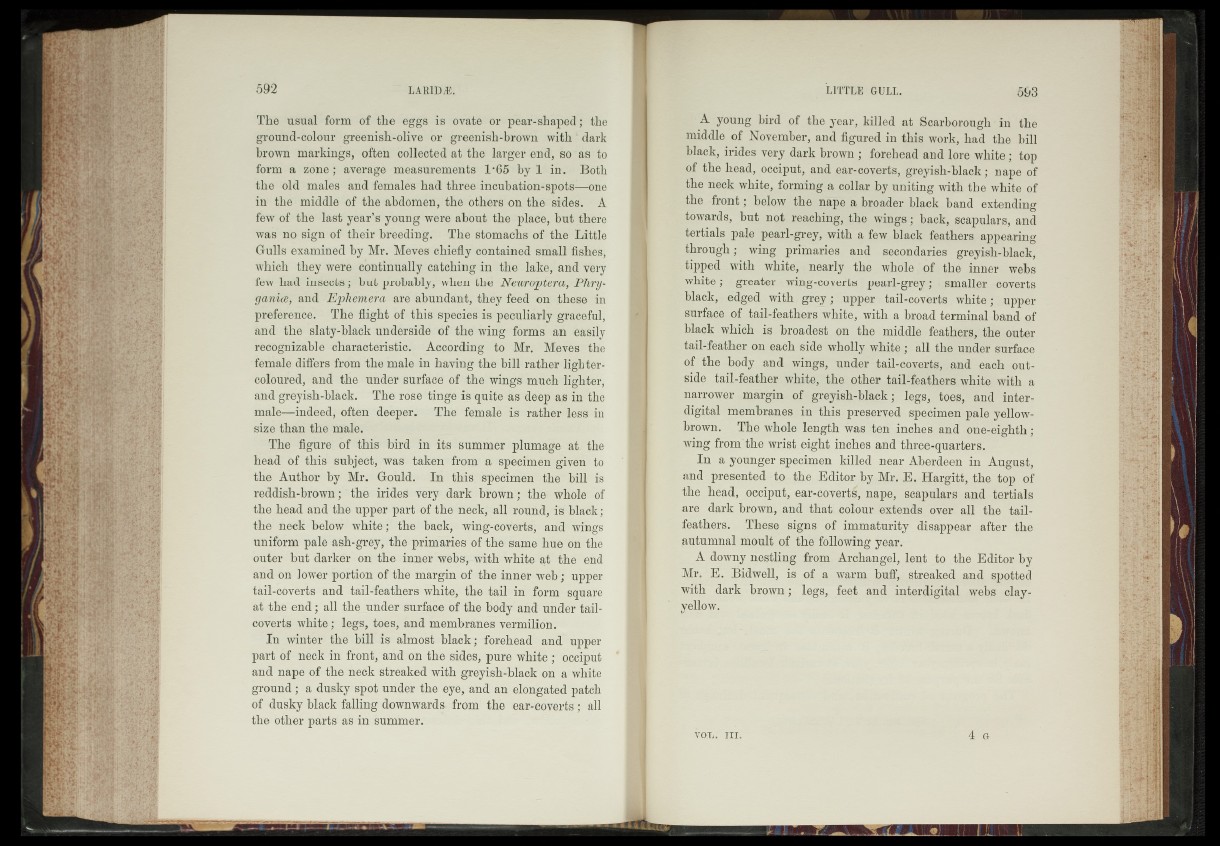
The usual form of the eggs is ovate or pear-shaped; the
ground-colour greenish-olive or greenish-brown with * dark
brown markings, often collected at the large# end, so 'as So
form a zone ; average measurements 1*65 by 1 in. Both
the old males and females had three incubation-spots^—-one
in the middle of the abdomen, the others on the-sides. A
few of the last year’s young were abdut the place, but there
was no sign-of their breeding. The stomachs of the Mttle
Gulls examined by Mr. Moves chiefly contained small fishes,
which they were continually catching mi the lake, and very
few had insects ; but probably, when the New&ptem^Miry-
ganiæ, and Ephemera are abundant, they feed on these- in
preference. The flight of this species is peculiarly graceful,
and the slaty-black underside of thé wing forms’ an easily
recognizable characteristic. AccórdingMto Mr. Moves' the
female differs from the male in having the bill rather lij|jafJr-
eoloured, and the under surface of the wings much "lighter,
and grèyish-black. The rose'tinge is quite as* deep as illthè
male—indeed, often deeper. The female is rathêr>iess in
size than the male.
The figure óf this bird in its^Summer plumage -&t.; the
head'of this subject, was taken "from a-specimen‘given p.
thé Author by Mr. Gould. In this specimen the bill |s
reddish-brown ; 1 thé irides/wery dark brown ; the* WMôIé^of
the head and the upper part o f tlè meek, sail ’ round, is bfeck ;
the neck below white; the back, wing'-coverts/ and* wibgs
uniform pale ash-grey; the primaries of the same hue on "the
outer but d a r k e r - o n the inner "websywifh white at the end
and on lower portion óf the margin; nf^thé inner web; upper
tail-cóvêfts and tail-feathers white, the- taih in form- sqûare
at the end; all the under surface-è f the body and under tail-
coverts white; legs, toes, and membranes vermilion.
In winter' thé' feîffâs MShoSt^bl'éck-; forehead " and upper
part of '-heck in front, and on the sides, pure white ; bböipiit
and nape of the neck sfreakèd with'greyish-black-on a white
ground; a dusky-spot under the eye, and an elongated patch
of dusky black falling downwardsyfrom; thé ‘ear>cóver4Éy -all
■the other parts as in summer.
A young bjrd of the year, killed at Scarborough • in the
middle of November, and figured in this work, had the -bill
black, irides very dark brown ; forehead and lore white; top
x of the head, occiput, and ear;eqyerts, -greyish-black; nape of
the neck white^forming a collar by uniting with the white of
the front; below the nape a broader black, band extending
towards, but not reaching, the wings; back,, scapulars, and
. tertials pale pearl-grey, with a few black feathers appearing
through; wing primaries and secondaries greyish-black,
“/tipped with, white, nearly the whole /of £ the inner webs
white ; greater wing-coverts pearl-grey; . .smaller -coverts
'black, -edged with, grey; /upper ta il^ je tls white ; upper
/surface of tail-feathers white, with a broad terminal band of
black which is broadesjfc..on the middle feath^g;:fhe outer
tail-feather on-.each side wholly white*; all .the;under surface
of the-body and wings, under tail-cove-Bta. and, each outrid
e tail-feather white, the other tail-feathers, white with a
narrower margin of greyish-black /""legs, ."“toes, and interdigital
membranes -:d-n this preserved specimen pale yellow-
brown. The whole length was ten inches and one-eighth;
wing from.'the-w#i'st eight inches and three-quarters.
In a younger specimen killed near Aberdeen in August,
and presented---^^gEditor by Mr. E. Hargitt, the top of
ftbe head, 'occiput, ear.-covej^ nape, scapulars and tertials
pee dark brown, and that colour extend« over all the tail-
feathers. These signs immaturity disappear after the
autumnal moult of the following year.
A downy nestling .from Archangel, lent jo the Editpr-by
Mr. ‘ jj|| Bid well, is' of a warm buff, streamed and sotted
Hitfr dark brown; legs/’ f | | | and interdigital webs clay-
yellow.